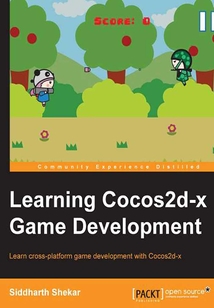目錄(100章)
倒序
- 封面
- 版權(quán)頁
- Credits
- About the Author
- Acknowledgments
- About the Reviewers
- www.PacktPub.com
- Support files eBooks discount offers and more
- Preface
- What this book covers
- What you need for this book
- Who this book is for
- Conventions
- Reader feedback
- Customer support
- Chapter 1. Getting Started
- Downloading and installing Visual Studio
- Downloading and installing the Windows Phone SDK
- Downloading and installing Python
- Downloading Cocos2d-x
- Creating a new project
- Coordinate system
- Basic classes of Cocos2d-x
- Project breakup
- Running the project on multiple platforms
- Summary
- Chapter 2. Displaying the Hero and Controls
- First things first
- Displaying the background image
- Character movement
- Enabling the touch function
- Enabling multitouch
- Movement with touches
- Movement with the accelerometer
- Custom controls
- Summary
- Chapter 3. Enemies and Controls
- Creating the enemy class
- Adding the gameplay layer
- Creating the projectile class
- Adding hero controls
- Summary
- Chapter 4. Collision Detection and Scoring
- Theory of collision detection
- Coding collision detection
- Keeping track of the score and the game over condition
- Storing high scores
- Summary
- Chapter 5. HUD Parallax Background and the Pause Button
- Texts and fonts
- Creating the HUD layer and displaying as well as updating scores
- Creating the pause button and showing the pause screen
- Implementing pause and resuming the game
- Adding the scrolling layer class
- Creating the parallax scrolling layer
- Summary
- Chapter 6. Animations
- Animation basics
- TexturePacker
- Creating a spritesheet for the player
- Coding the player animation
- Creating and coding enemy animation
- Creating the skeletal animation
- Coding the player walk cycle
- Summary
- Chapter 7. Particle Systems
- What is a particle system?
- Cocos2d-x's inbuilt particle system
- Adding the gun muzzle particle system
- Adding an explosion particle system
- Adding particles for jetpack when a player moves upwards
- Creating your own particle system
- Summary
- Chapter 8. Adding Main and Option Menu Scenes
- Creating the main menu scene
- Loading the menu scene at start of the app
- Creating the Options scene
- Changing the name of the app
- Summary
- Chapter 9. Adding Sounds and Effects
- Audio in Cocos2d-x
- Adding looped background music
- Adding sound effects
- Adding the mute button
- Summary
- Chapter 10. Publishing to the Windows Phone Store
- A look at the Windows Phone Store
- Creating the store account
- Preparing/creating the app
- Creating the app and setting pricing
- Uploading the XAP file icons and screenshots for review
- Summary
- Chapter 11. Porting References and Final Remarks
- Running the game on the Windows desktop
- Running the game on the Android simulator using the Eclipse IDE
- Running on the BlackBerry simulator using the Momentics IDE
- Running on an iOS simulator using Xcode
- Additional learning resources
- Final remarks and a thank you note
- Index 更新時間:2021-08-05 18:00:40
推薦閱讀
- Istio入門與實戰(zhàn)
- 深入理解Spring Cloud與實戰(zhàn)
- Manage Partitions with GParted How-to
- INSTANT ForgedUI Starter
- 平衡掌控者:游戲數(shù)值經(jīng)濟設(shè)計
- 嵌入式系統(tǒng)中的模擬電路設(shè)計
- 超大流量分布式系統(tǒng)架構(gòu)解決方案:人人都是架構(gòu)師2.0
- RISC-V處理器與片上系統(tǒng)設(shè)計:基于FPGA與云平臺的實驗教程
- Istio服務(wù)網(wǎng)格技術(shù)解析與實踐
- WebGL Hotshot
- 圖解計算機組裝與維護
- FL Studio Cookbook
- 單片微機原理及應(yīng)用
- 觸摸屏應(yīng)用技術(shù)從入門到精通
- FPGA實戰(zhàn)訓練精粹
- 微服務(wù)架構(gòu)基礎(chǔ)(Spring Boot+Spring Cloud+Docker)
- 筆記本電腦現(xiàn)場維修實錄
- PLC技術(shù)實用教程
- Liferay 6.2 User Interface Development
- Blender 2.6 Cycles:Materials and Textures Cookbook
- Ouya Unity Game Development
- Xilinx FPGA高速串行傳輸技術(shù)與應(yīng)用
- 歐姆龍CP1H系列PLC完全自學手冊(第二版)
- 單片機技術(shù)與項目實踐
- 嵌入式系統(tǒng)軟硬件協(xié)同設(shè)計實戰(zhàn)指南:基于Xilinx ZYNQ(第2版)
- 電腦組裝與維修寶典
- 量子霸權(quán)
- PySide GUI Application Development
- 青雨紅顏:Photoshop古風水彩CG插畫繪制技法
- 單片機從入門到實戰(zhàn)(視頻自學版)


